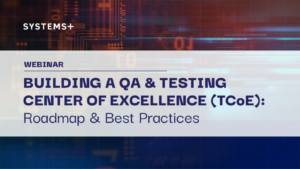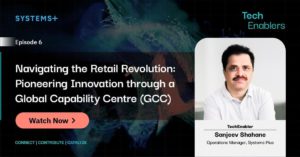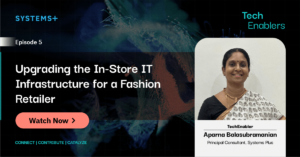Developing your enterprise cloud migration and implementation strategy


With
CEO and Co-founder QloudX
Technology is often utilized to develop new business models, products and services, and strategies, ultimately leading to market leadership. The term “Enabling Digital” refers to this.
The podcast series explores how CIOs can capture opportunities by looking at and beyond technology and data to propel their organizations into the digital forefront.
The podcast series looks at how independent thought leaders and visionaries from the tech industry across the globe bring their ideas to scale within the business world, sharing innovative, path-breaking insights with our listeners.
We interview experts on trends and best practices for IT leaders. Sapan Choksi, CEO at Systems Plus, talks monthly with tech thought leaders on 21st century business topics like innovation, digital transformation, AI, and automation.
We are excited to be in conversation with Niklas Palmqvist on ‘Developing your enterprise cloud migration and implementation strategy.’, as part of our Enabling Digital podcast series.
Niklas has spent the last 10+ years in various ‘C’ level roles for multi-national shipping & logistics & software companies. He has extensive experience working across different cultures & business practices after having lived and worked in the USA, Europe & Asia.
He has successfully spearheaded and successfully delivered multimillion-dollar projects and Digital Transformation/IT Strategies for various customers around the globe. Niklas is a technologist at heart, where he enjoys the execution of these solutions with a heavy focus on modern and disruptive technologies such as Cloud Computing.
QloudX was established as a strategic alliance/extension brand of Systems Plus which was co-founded by Nikunj Jhaveri (Founder of Systems+) & Niklas Palmqvist to create a next generation Cloud Company, which focuses on all aspects of Cloud & help businesses across the globe to leverage Cloud Technologies, in order to maximize their digital transformation journeys.
QloudX is proudly headquartered in Denmark (Europe), with having a strong outreach extending to continental Europe, USA, Asia & India.
Learn more: https://www.qloudx.com
Sapan Choksi 0:00
Okay, okay, so let's kick this off. Here, everyone, Welcome to Enabling Digital Podcast Series. My name is Sapan Choksi. And I'm here today with Niklas Palmqvist, co-founder and CEO of Convex. Niklas, it's great to have you here.
Niklas Palmqvist 0:26
Yeah. Hi, Sapan, thank you for inviting me. It's great to be here as well. Awesome.
Sapan Choksi 0:31
So, for those who don't know Niklas, Niklas actually has spent over 20 years in various ‘C’ level roles of multinational and Shipping and Logistics companies, as well as Software companies, he has a lot of experience working across different cultures and businesses practices. And he's lived well, pretty much all across the world, US, Europe and Asia. And so, I mean, he's got something test experience. And, and it's really mind blowing, the kind of knowledge he has on some of the Cloud areas. And so, what we're gonna talk about today, so he's actually successfully spearheaded and delivered multimillion dollar projects, in and around digital transformation, IT strategies for various client's customers around the globe, he was working for a large global company, and therefore he got a lot of sorts of views and access to how different regions to business, etc. So, I mean that the conversation today is going to be fantastic. Nicholas is a Technologist at heart. But he is a business guy, he understands business really well, really, really well. And he enjoys execution of the solution. So, he really likes to get his hands dirty. And today, his focus is really on modern and disruptive technologies, such as Cloud Computing, I would say, he is not only an expert, he is an evangelist. So, Nicholas, welcome once again, and let's sort of dive right into it. So, Nicolas, I'm going to start by asking you, you know, sort of the million-dollar question, right? Cloud is such a big word, right? What does it mean to you?
Niklas Palmqvist 2:10
Yeah. Oh, wow. Let me first comment on that introduction. That's the nicest thing I've heard in a long time. So, some of the things I'm proud of when they were new, saying that, you know, more than two decades, so it's just sounds. That sounds like it's too long. But yeah, it's true. So, but thank you. So, I'm so Cloud. Yeah. I mean, it's, it's obviously a very broad question and a difficult one, right? And we hear and see customers, and basically everybody had it has moved up. I mean, cloud used to be an IT discussion. Then it moved up to CIO and CTO level and then moved up to the whole C suite. And now we see a lot of those conversations on a board level, there multiple articles, or even from McKinsey in the likes. Right, saying, Okay, here's board advice. How do boards handle cloud? How do you discuss it from a strategic perspective? And again, to me, that's pretty, it's very interesting and impressive. So, it's a board level discussion these days. So, it's impacting people's businesses is not only about IT. And I think that's the evolution of the cloud as well. It has moved from being basically you have a technical toolbox that mostly IT people are using, it could be for storage, or you deploy a few servers, etc. But again, now, it's highly strategic, even on the business level.
Sapan Choksi 3:30
Yeah, I agree. I mean, that the whole cloud concept has become so strategic. I mean, initially, when people used to think cloud, you should they pretty much migration, but that old thinking has changed and has to change. I mean, what are your thoughts on that?
Niklas Palmqvist 3:45
Yeah, no, I You should. I mean, it's hard for people to understand cloud, right. And we spend quite some time on explaining what is cloud today. And obviously, it's moving so fast. And that's one of the biggest challenges also for customers to keep up. Right. So that's a big part of our job to basically explain what is the cloud? How can you use it? And, you know, I normally start and, you know, tell people's like, you know, cloud and they say, yeah, that's where I can store my pictures, you know, from my phone. And maybe if they're a little bit more advanced, yeah. Okay. I can provision servers, I can run some service only pay for hours that are and until them Yeah, that's correct. But that's basically cloud 10 years ago, if you look at some of the products that have been available, if you take Amazon s3 storage service went live in 2006. So obviously, that's more than 50 years ago, and in cloud years, I mean, that is even longer. It a lot of things have changed, right? So, it's starting from that very basic level, and then explaining Okay, based on those two services, the basic services, what has happened the last 10 years, how do you apply that to your strategy? How can those tools be used, etc. But yeah, it's better long and sometimes a little bit challenging conversation.
Sapan Choksi 4:49
So, I'm going to take you back a little bit, you know, Initially, most people thought, or always used to think that and many people still do for that matter, that cloud is just about lift and shift of applications. Right. But But I want to get back to your CIO days. And when you are running a product, right? How did you start thinking about the cloud? And how did you convince your board to actually go down that path?
Niklas Palmqvist 5:20
I guess it's a little bit of a long answer. But it started internally, you know, when you're running a business, and it doesn't matter if it's software business, or any kind of business, right, you're looking at, how can you become more efficient. And in this case, we're developing a fairly large product, we had teams split over three countries and a total of roughly 130 140 people. So, it was very important to see how can we become more efficient in development. And that's a journey that never stops, right? Because you want to you want to enhance your product at all times. So, you know, you do weekly, daily, hourly, whatever releases, how can we move faster? How can we create more value? So, we looked many different places, we looked internally, you know, how can we be better at agile? Can we implement more tools? Can we do this and that as part of that conversation, cloud was there. So, we started to use more and more cloud services. And keep in mind, this was quite some time ago. And I don't think that DevOps was that well known. But we started to practicing DevOps so we could automatically release or build and release software, etc. We could do automated testing, we started automating more and more things. We started to use containers before Kubernetes, for example, was born, mostly based on Docker containers, etc. So early adopters, and then we found out that yeah, I mean, Cloud is already mature enough, where we can see the business becoming more efficient, where we're creating more value along the way, because we're using these tools. So that's basically where it started. But we looked at Cloud as a very large toolbox, you know, compared to the more traditional toolbox, which is smaller, right? And then we started to investigate that toolbox and, you know, trying out services. And I think that's part of the answer to right. Cloud is great. But you need to understand what parts work for you. And there are parts that are maybe not a good fit for you. So, it's also very much about experimentation. And experimentation in the cloud, is fairly easy, and it's fairly cheap. So, you try something else, maybe small proof of concept, it doesn't work out, that's fine. You fail fast, and then tweak things and eventually, Richard.
Sapan Choksi 7:35
So then, you know, 10 years ago, people used to just think I'm just by moving to a Cloud, I'm just shifting CapEx to OpEx. I know the way, especially the big three have evolved their cloud sort of offerings, from AWS to Azure, or to even Google. You know, it's not just as simple as saying, moving CapEx to OpEx. But it's very difficult to convince sort of your CFO, etc., especially when you're moving from CapEx to OpEx. So how would you suggest people help the CFOs? Get there?
Niklas Palmqvist 8:15
No, I think you also have to consider where people and companies are at. Many times, when you talk about the cloud, people like to talk about artificial intelligence and machine learning, analytics and various things. And that's all great. But if you look at many companies, bread and butter is still you have a bunch of servers that are running your mission critical applications. Again, that's not everything. That's a big piece of the puzzle. But again, look at the toolbox, saying, Okay, I have this application can be an Oracle Application, or whatever it is, okay, it needs to run in a specific way or a specific purpose. So traditionally, people have bought their hardware, they spend months on requiring that hardware, and configuring it, installing it, etc., right, and then deploying it. And then after over the years, there are people tweaking this. So, you have this manual setup that works very well. But it's still a server, or multiple servers, if you will, right. So in the cloud, if you just look at when you go in and buy a server, if you look at AWS, I mean, it's not one server you buy, um, you literally have more than 100 server types. So depending on the application is a database do you need is a graphics heavy application, you have all these different options that are tailor made to different applications. So it means that it becomes more effective, right? And when it becomes more effective, you can also scale it properly. So when when you do capacity planning, traditional capacity planning, you tell the CFO and saying okay, I need to invest $200,000 I'm just picking a number right for this server for this environment, and it's over provisioned, because you know that there's going to be natural growth could be 20% per year or whatever, right. So you need to cater for that growth all along. But that also means you're paying for idle capacity. And again, it's not specialized yet commodity hardware that people need to then configure and make, you know, into a specialized solution. So again, now we go back to the cloud, we have a larger toolbox, with all these at least 100 server types where we can pick and choose the perfect server type for this specific application. And then we scale it accordingly. So overall, the value becomes greater. And most of the time, the cost is less as well. And it frees up IT departments to focus on what they should really focus on creating value for the business.
Sapan Choksi 10:47
Right? I mean, I think indirectly, what you're seeing is you need to look at the total cost of ownership over the lifecycle of the server maybe or over a couple of years, as opposed to just what's happening at that point in time.
Niklas Palmqvist 10:59
Yeah, and that's a very important point, that total cost of ownership is, it's sometimes tricky for people to define, because it's so easy just to look at, okay, what have we bought? You know, we're talking about service? I mean, how much did we spend to spend those $200,000? we depreciate over 36 months, how much is a cost per month? Right? But if you look at the total cost of ownership, I mean, again, you have a lot of manpower that's tricky to define, because it's an internal cost within IT department are not logged properly, etc. Make it even more complex, you have power and cooling in a datacenter. So how much of that and you have internet, right? I mean, how much of that is actually are that cost is tied to this specific application. Most people don't know that often. That's also something that we help people with to try to define that. So whenever you understand the total cost of ownership, it's much easier right? To compare to the cloud costs, because it's very fixed, you pay X cents or X dollars for this specific workload. And on a monthly or recurring basis, right. So so then you have you can compare apples to apples, and it's not apples to oranges, right?
Sapan Choksi 12:06
No, that's, that's great advice. I'm going to, I'm going to try to get back to some basics, right? Imagine, you know, and this is where most companies start is taking a core application, and then moving that to the cloud. So, you don't think of it as a simple migration process, right? are lifted, shipped us as often it's called, what are the steps one should think about going through that process? You know, do I need to think about because I'm doing this or going on this journey? Do I should I look at we architecting, my sort of, you know, application? Or what kind of dependencies ready to be thinking about? I mean, what, how would you sort of, you know, and I know, I know, it's, there's a lot of steps involved. But if you had to, you know, answer me at a high level, what would you say? What are the start things that someone should start thinking about, you know, who may not have a very strong IT department, per se, or just thinking about going on this path?
Niklas Palmqvist 13:35
Well, first of all, you should ask the question, why we're doing this, right, so So before we decide we need to do lift and shift, right, we need to understand why we want to do lift and shift. So that's normally when people look at different migration strategies. And in the cloud world, it's called the R's. Back in the day, we had like the five R's and then became the six R's, and I believe we're up to the seven R's. So what are the R's? Well, that's basically anything from Re-platforming an application, you could Retire an application, you can Re-architect an application, etc. So you need to go through and understand those seminars, and basically pick the one that is useful for you. So even retire, you know, sometimes that is an option, right? And saying, Do we really need this application long term? Is there not another alternative? You know, there could be a SaaS application that we go out and buy? Okay, if that's a better solution, then this application should be retired, it should not be moved to the cloud, on the other hand, is saying no, it's maybe mission critical. So we know we need it. But then you start to look at the application. But how mature is it? Is it a modern application? Does it contain a lot of legacy technology? And that's what we see a lot these days that people have a lot of mission critical applications, but their legacy technology, they're not keeping up. And different components are becoming end of life with the database could be the dotnet version, or whatever people are using. Right? So then the question becomes, how do you modernize this application? And again, that's an example. Sometimes you need to re architect it, because you're, you're moving to the cloud. I'd say the traditional way to go. And well if there is a tradition, but a lift and shift is normally a good step. But again, that is just a copy paste. You unlock some value by doing that, because you are in the cloud, but People sometimes misunderstand that. Okay, then I'm done right? Now we move to the cloud. But no, that's when the fun starts. Because again, coming back to this toolbox, right? So all of a sudden, you have unlocked this enormous toolbox. And now you can really start to create larger value within the application itself. But again, it's highly individual, what kind of application is, you know, instead of homegrown custom application? Is it an Oracle application that is more can that we just need to host? So again, that's also why you have these different strategies. But again, the strategic angle is important to discuss and understand what is the lifespan of the application? What are the end goals of the application? And then you can map out ho w you get there. Right now, if that makes sense?
Sapan Choksi 15:46
No, that makes perfect sense. And actually, it's very sound advice. Thank you for that. I want to shift gears a little bit. Typically, when we think cloud adoption, and in general, I would say, people think outside of IT, at least people think, oh, it's that's a tech play. Right. But you know, and I keep an I keep telling people that No, no, Cloud is not about it's not a tech play, per se, it depends a lot on your organization, especially the people and process. Right. So how do you advise clients in terms of how do you bring the people in the process along with you? While we're on this journey, as opposed to just keeping it in your mind that it's gonna get technical, and therefore sort of relegated only to the IT department? Because that's not the case anymore?
Niklas Palmqvist 16:35
Yep. No, and as you said, in the beginning of the conversation, it's, it's not easy. It starts with a lot of conversations normally on a higher level. And I think there has to be buy in from the sea level and the board to be the become truly successful. But I think that's, it's definitely happening. And we've seen that a lot of organizations even in let's call it more traditional industries, they have hired a Chief Digital Officers. So in addition to the CIO, right, I mean, they have a CTO, that is pushing the transformation. And with that, there are more conversations on the sea level and also in boards, because I mean, how if you want to come digital, what does it mean? How do you get there, as part of that conversation, Cloud is important. You don't have to do cloud, you can do it, the traditional way, is just very painful, and very expensive as well. So that is why you need to understand and embrace the cloud, if you want to become more digital. And on the IT side, I mean, you can do it still traditional, and maybe have a stronger argument, if you have sized and design your data centers, well, etc. If your cost effective, then maybe you have a better argument. But it's still like, Andy, Jesse from Amazon is saying, you know, fighting cloud is like fighting gravity, eventually, you will run into trouble. Because we need to understand and embrace it. But yeah, change is difficult, right? And it becomes also cultural. So, it is a journey for people. Um, you can't expect for people to adopt and understand cloud from one day to the other. There's also a fear by some people, like, Am I losing my job, you know, because I don't necessarily know cloud today. So how somebody else gonna do my job. But as we tell people, you know, things change, and it's not about you losing a job, it's about upskilling. It's about doing things differently. And I think overall, especially IT people are used to that, right, because you can't stand still. In the IT world. I mean, you constantly need to upskill and you need to embrace new technologies, because otherwise, you're left behind.
Sapan Choksi 18:41
Right? I mean, you mentioned that, you know, in your previous organization, one of the one of the causes behind adopting cloud and was to become more agile, but that's really difficult to do for larger organizations to sort of become agile, sort of move in a freer flowing way, etc. Just not, you know, there's usually a lot of inertia there, etc. So, how do how, how do you advise or how do you help large organizations think about the cloud, the cloud adoption process? And how would you suggest they break down the process to start, you know, embracing the cloud over a period of time? Right?
Niklas Palmqvist 19:29
Yeah, I mean, we start with agile, scaling, agile and or large scale Agile is in my experience very, very difficult. Yeah. And also, that's normally what people say I mean, that that is just challenging overall. For small organization it's easier to implement etc. But you know, from an agile perspective, basically to change your whole organization to become agile. First of all, what is agile how do we define what does agile mean to us right, right and then rolling that out. That is, that is not easy, can be done, of course, but It's not easy. I think on the cloud side, you need to start to create some quick wins, you need to build some credibility within the organization on saying, Okay, we try it out. And we did a proof of concept as an example, right? And see, you know, it took us two weeks and across those, I don't know, $1,000, compared to if you do a traditional way, much longer, much more expensive, etcetera, then people start to become interested in ask questions like, oh, well, how do you do that? I mean, could you even do that, and, you know, show us in a way, so many people start what's called a Cloud Center of Excellence. So instead of impacting the existing organization, you set up a smaller team to start with, and they are tasked with and saying, Okay, how can we produce some of these proofs of concepts and maybe some quick wins, that we can show the rest of the organization to get some some Biden's?
Sapan Choksi 20:53
I said, That's a great idea.
Niklas Palmqvist 20:56
Yeah, because then you can run in parallel, right. And you don't have to, you don't have to fight the cultural change. I mean, it becomes more organic in a way. And we've helped customers do that as well, especially with proof of concepts. If you look at the cloud providers, and how we operate as well, I mean, we love building proof of concepts. And like I said before, it's not always they're successful from day one. But in the cloud, you should experiment, and then you tweak and then they become successful. But the the upfront investment to build a proof of concept is normally very low in terms of cost and risk and commitment, right? And then you can take that value, and the leadership, being CIO, whoever it is, can use that internally and say, hey, we're building these great things, should we have discussions to learn a little bit larger scale, and they can roll it out? You know, across business units or across teams? And you basically take one piece at a time.
Sapan Choksi 21:49
I do I definitely do agree with you there. I, I have seen that the Cloud enables you to take quicker, faster risks, faster decisions, I would say, you know, almost fail fast, right? The cloud does maple back in a much better way compared to the traditional sort of ways of working. But I do want to now shift a little bit to sort of, you know, real industry scenarios, right? I mean, I know, you do a fair bit of work with different retailers. And, and, you know, retailers have picked up or jumped on the cloud bandwagon in a significant way. And there's, you know, you name sort of the solution that retailers use across the board. And, you know, there's, there's, there's some flavor to it. But, but how do you sort of advice your retail clients to maximize the value from the cloud, just just beyond the hassles of, you know, maybe data storage, or cost of computing, etc? I mean, there's, there's so much more, there's so much out there. So how do you go about that journey with the retailer? Clients?
Niklas Palmqvist 23:00
Right, I think one topic that is hot for retailers, that we've seen over and over again, is if we start in Dana data, and again, like we said before, it's important to understand where clients are at and mapping the journey of to the cloud. And I wouldn't call this backwards, but you know, starting with basically data strategies, maybe a little bit more advanced, and you know, instead of talking about lift, and shift, etc. But data challenges are definitely a thing within the retail industry, especially for for traditional retailers that are competing with the Amazons of the world, right. Very true. Very, so true, it's more they have these workloads. And you know, like we said, could be Microsoft, Oracle, and SaaS applications, and, you know, Salesforce or whatever they're using, and they, they, of course, operate individually. And there may be a somewhat integrated, and, you know, some are SaaS application, some are on premise. And the question is, how do you connect all these applications? And how do you get more visibility and value from all of that data, not just one or two data sources, but all the data sources. And we've seen that accelerate, especially during COVID, as well, and after COVID, and people are doing more online shopping and sort of there's a greater need to understand your data and use your data as a tool. So So again, the question is, how do you do that? Well, you can do it multiple ways, right? You can do it that traditional way. You can try to build your own environments, build your own applications, etc. doable, but very painful, very costly. So back to the toolbox. If we look at the data services, we have within the cloud, right, the readymade services on many different levels. Keep in mind that we talked about these hundreds of server types you could choose right, so similar on the data side, you know, you have you have multiple storage options, different databases for different purposes. You have data pipelines; you have data security. You have all these services you can build in a solution. And yeah, you can, it's one clicks to enable them. You know, okay, sounds too easy meet me anyway. But yeah, that's where you start. You don't have to buy service etc, you can you can build solutions more on the fly. So yeah, to answer your question, basically, for retail companies coming in looking at data, how you can put together and build a data solution, for example, built on a data lake or data fabric, and how you start to create value and visibility to that data. Those are those are definitely hot topics and something that we're helping quite some retail customers with.
Sapan Choksi 25:37
It's fantastic. So last question, from my side, it's a little bit of a I've been hearing it a lot less now. But it was definitely very prominent a couple years ago, which was that, you know, obviously, one of the leaders in this space is AWS, which whose parent company is Amazon and for retailers? That was, you know, in a sense, a big no, no saying no, no, we don't support Amazon in any way, shape, or form, because they will they saw them as competitors, and their business, etc. I think many retailers have shifted that mindset, because it's not about that. And there are definitely you can coexist with Amazon, even as a retailer. And of course, AWS, if it's a better solution, why not use it? But how do you advise your your clients, especially in the retail space to go one versus the other? Or why not? Why not? Why why not? Pick not pick? Amazon just because it's seen as a retail competitor? Because that's that shouldn't be consideration, according to me.
Niklas Palmqvist 26:45
Yeah, no, it's a good question. And while there are many answers, and it's a conversation that needs to be, yeah, it needs to be discussed in detail, and probably on a senior level, right? Because I mean, it's about defining risk. So you can look at it many different ways. But if you look at Amazon, they have actually unique business model that people don't realize. So if you look at let's call it Google, or Microsoft faster, or the other cloud providers, right, essentially, they're IT companies, and they're good at what they do for sure. They release products in terms of, let's call it data or servers, whatever, you know, you can use as part of that toolbox, Amazon and AWS to have a slightly different mindset. I wouldn't say all but if you look at most of the products, they offer that AWS offer today, they're not coming from AWS, they're actually coming from Amazon. So there are many stories right in the saying, Okay, we as Amazon, we had a problem. It could be, you know, databases, or again, visibility of data, call center applications, whatever it is, right, they had built all all of that internally for Amazon. And they're actually very good at building those applications. So they don't release it right away. They spend years on them, and essentially try to make them perfect when they say, Okay, this is working for Amazon. And they say, we can release this to other competitors, essentially, right, if it's a retail business, and they do that through AWS. So again, it's back to the toolbox. So then you get access to these tools that are also still being used by Amazon, internally. So try it and test it. And then everybody else can use them. And I think that's a really good advantage that Amazon has over over Microsoft and Google and other providers is that it's very specific to their business and tried and tested. And it's just has a different flavor. It has a business perspective to it, right? So there's a deeper understanding of the business at hand, which in my perspective, make the products better.
Sapan Choksi 28:53
That is, that is indeed a very, very good way to think about it. Because I know we can go on for hours and hours. But we do. We are running out of time. So I want to thank you once again, for joining us. And thank you again, to everybody for joining our Enabling Digital Podcast Series. For those who are interested. Nicholas is going to actually be at the reinvent event in Vegas at the beginning of December. So you know, feel free to look him up. He'd be happy to shoot the breeze with you. It's Niklas Palmqvist at Cloud X. And I'm Sapan Choksi signing off. Thank you once again, everybody
Niklas Palmqvist 29:34
Thanks, everybody. Thanks

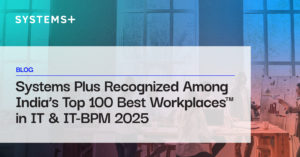
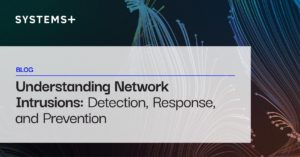
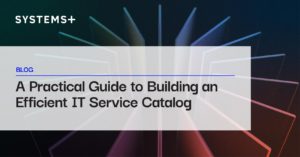
Amazon Web Services
Know MoreAmazon Web Services
Know MoreAmazon Web Services
Know More